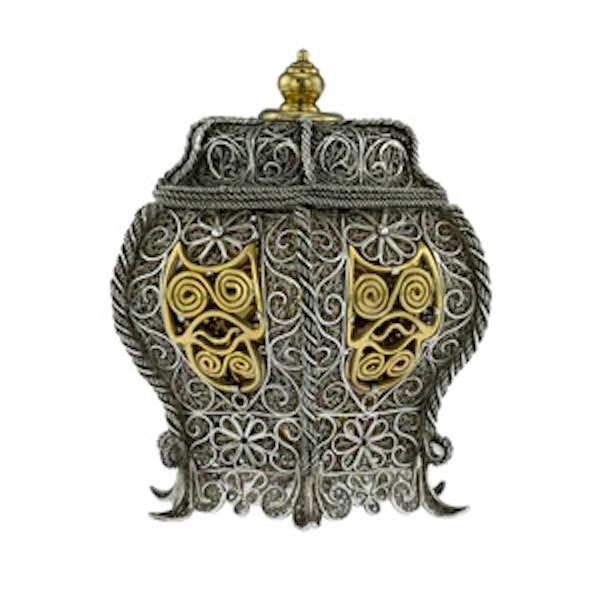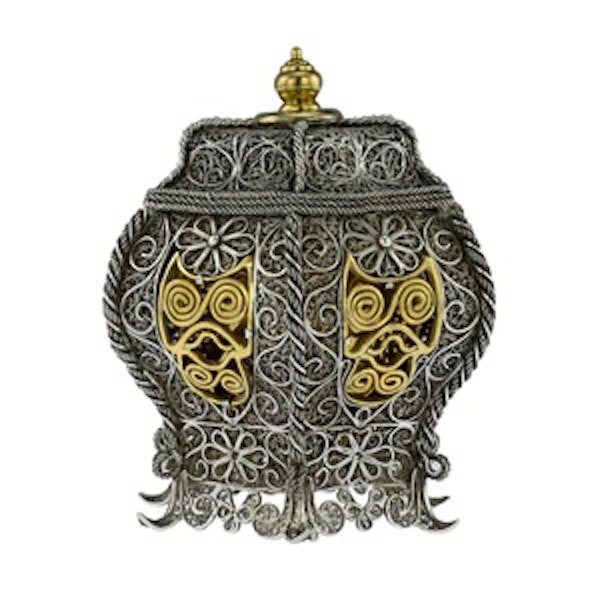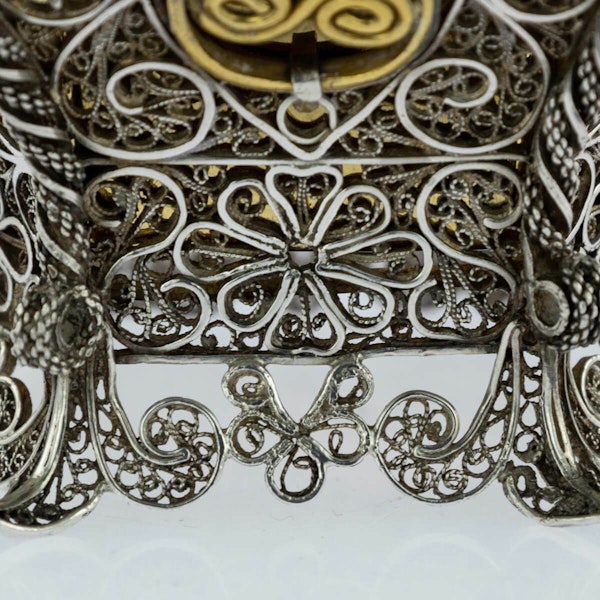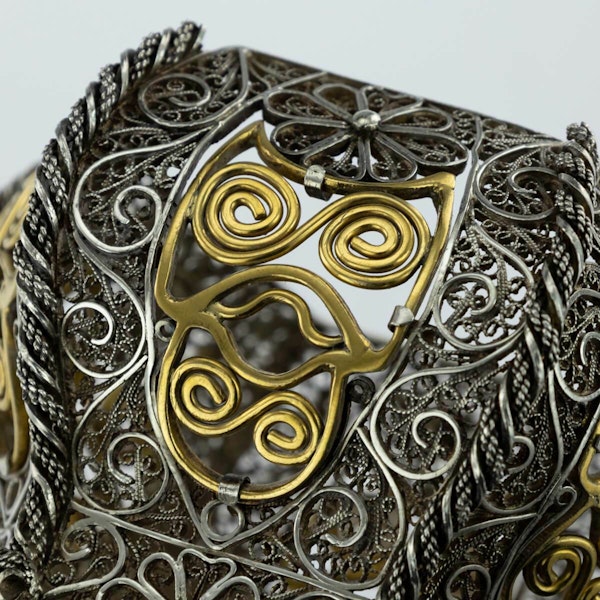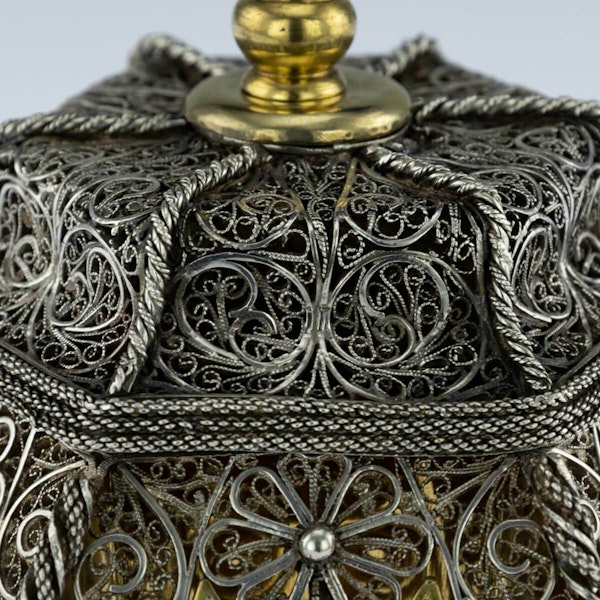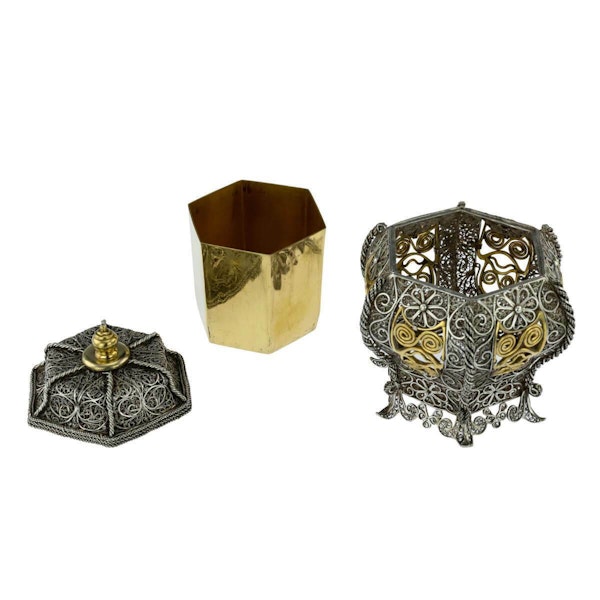Antique Sumatran Silver Parcel Gilt Betel Container, Indonesia - 18th Century
Antique Sumatran Silver Parcel Gilt Betel Container, Indonesia - 18th Century
£11,000.00
Description
This very fine antique Sumatran parcel gilt silver filigree betel container is of bellied hexagonal shape and comprises three parts: the filigree container which stands on six filigree curled leaf shaped feet, a lift off filigree cover and a removable hexagonal silver gilt liner. Although a number of 18th century Sumatran silver filigree betel boxes are known, the design of this box is fascinating and extremely unusual, particularly with respect to the applied braided silver ropework to the edges and the gilt ‘tribal style’ figures, resembling owls, which appear almost three dimensional and as if illuminated by moonlight, positioned against the richly gilded metal behind them. These figures can be found at the mid-point of each of the six sides and influenced by the metalwork of the Batak people. The filigree cover has been lined with gilded sheet silver to the underside and has also been ornamented to the interior with applied filigree floral and foliate elements to the flat section to the top, once the cover is in place.
This container is an absolute tour de force of filigree work which uses wires of different thicknesses and profiles in a variety of different ways. The craftsmanship is superb, the design has been planned with great care and imagination. It has been executed flawlessly. The box bears no silver marks, but the metal has been tested and the tests confirmed that it has been made from high grade silver whilst the finial, tribal panel designs and removable hexagonal liner are of silver gilt.
This container was made to safely store and carry the array of ingredients needed to prepare a betel quid. Betel containers were important objects which reflected the status of their owners. Chewing betel and offering betel to guests were important rituals which permeated all aspects of everyday life and ceremonies were part of the prevailing social and business etiquette. The removable gilt liner would have been filled with smaller boxes, tools and packages containing all the ingredients necessary to prepare a betel quid.
In 1784, William Marsden published ’The History of Sumatra’, following his travels to the island. In Chapter 15, he discusses the betel ceremony and describes two containers owned by the Sultan of Moco-moco which seem to compare closely to this one in terms of their size, shape and being fashioned from precious metals. Marsden wrote:-
‘This custom has been accurately described by various writers, and therefore it is almost superfluous to say more on the subject than that the Sumatrans universally use it, carry the ingredients constantly about them, and serve it to their guests on all occasions--the prince in a gold stand, and the poor man in a brass box or mat bag. The betel-stands of the better rank of people are usually of silver embossed with rude figures. The Sultan of Moco-moco was presented with one by the India Company, with their arms on it; and he possesses beside another of gold filigree. The form of the stand is the frustum of a hexagonal pyramid reversed, about six or eight inches in diameter. It contains many smaller vessels fitted to the angles, for holding the nut, leaf, and chunam, which is quicklime made from calcined shells; with places for the instruments (kachip) employed in cutting the first, and spatulas for spreading the last.’
We are most grateful to Jan Veenendaal, an expert on objects from this region and author of ‘Asian art and Dutch Taste’, amongst other works, for his expert opinion and assistance in helping us to identify this container’s origin and date of manufacture. Jan believes that it was made in West Sumatra and dates to the 18th century, as the style of the filigree is consistent with other 18th century examples and 19th century filigree from the area was of a very different style. He thought that it was probably made for a member of the European community who was living in Sumatra. Another possibility might be that it was commissioned by a European as a gift for a Batak ruler or senior member of the tribe as we know from botanist, Charles Miller’s letters of 1772, quoted by William Marsden, that it was customary to bring gifts when visiting a Batak chief.
The European ex-patriot community in Sumatra comprised Dutch and Germans working for the Dutch East India Company (V.O.C.) and British in Bencoolen (now Bengkulu) a British possession on the west coast, south of Padang, which they held from 1685 to 1824. They had a smaller factory in Natar from the mid eighteenth century, close to Batak lands, to facilitate trade with the tribe, later establishing a post at Tappanuli in the heart of the Batak lands. From the Batak they obtained camphor, benzoin, cassia, brass wire and fresh produce for trade and provisioning ships. The British of Bencoolen managed plantations of nutmeg and pepper vines which were grown for export and they also exported Trippany, Bichos do Mar and edible birds’ nests. In his book of 1837, Edmund Roberts provides a vivid description of Bencoolen around 1833, about ten years after the territory had been ceded to the Netherlands.
Europeans acquired filigree objects for their own use, to give as gifts and/or to resell for profit to European traders who, in turn, supplied retailers and wealthy aristocratic collectors back in Europe who were always looking for something different to add to their collections.
Jan was certain that this betel container was made in Sumatra during the 18th century but added that he had never seen another example which incorporated Batak tribal style elements. He confirmed that the shape of the container was typical of objects from Padang, West Sumatra, home of the Meningkabau people and that the tribal figural elements and braided silver ropes were in the style of the Batak people. Similar braided metal ropes are also found in tribal jewellery from the archipelago. These decorative braided ropes feature prominently in this betel container’s design – applied as a triple row around the lower edge of the cover and as a single rope delineating the angles formed by the intersections of the six sides, running all the way down from finial to pedestal.
Marsden wrote that on festival days, the young women of the Batak tribe wore all gold jewellery instead of their usual tin and brass, including earrings, hairpins fashioned like birds or dragons, hollow bangles around their upper arms and three cornered breastplates. When describing the Batak mens’ clothing he says that they wore a scarf over their shoulders which they were fond of adorning with strings and tassels. It is probable that the men’s passementerie strings and the women’s bird form hairpins have provided the inspiration for and been referenced in this design.
According to Marsden, the Batak had three deities and the chief of these was Bataraguru, the ruler of heaven and father of all mankind. In the Batak’s version of the legend of the great flood, Bataraguru’s daughter, named Puti-orla-bulan, descended to earth on a white owl but there was nowhere on the flooded earth to set down so her father sent down a lofty mountain from heaven and she lived there. Whilst she lived on earth, she gave birth to three sons and three daughters and the whole human race came from her descendants. It is probable that the owl figures ornamenting the sides of the container may reference this belief.
In Europe, King Louis XIV of France championed the collection of filigree objects during the seventeenth century. Following his lead, the fashion became widespread and filigree objects were coveted, pursued, and collected with a passionate intensity. Whilst some filigree was made in Europe, much more was imported from the East, including India, China, and the wide trading area between these two, which included Sumatra, where filigree production is well documented. Writing in the late 18th century, William Marsden described Sumatra as the ‘emporium of eastern riches’. For centuries, this island was one of the important trading areas on the maritime silk road which connected Europe and the Middle East with Indonesia, India, China and beyond.
Many fine filigree objects came to Europe from Sumatra, often resulting from private trades instigated by individual Europeans living and working there, particularly those connected with the V.O.C., also known as the Dutch East India Company. Many of the V.O.C.’s 18th century warehouse and cargo inventories in Batavia (Java) refer to ‘West Coast Filigree’ or ‘West Coast Work’ indicating that an object, or objects, had been made on the West Coast of Sumatra. The city of Padang was the centre for Sumatran filigree production which was much admired in Europe. Mostly, Padang was under Dutch control during the 18th century save for a few months in 1781 and from 1795 to 1819, two periods when it came under British control.
Marsden wrote, ‘There is no manufacture in that part of the world; and perhaps I might be justified in saying, in any part of the world, that has been more admired and celebrated than the fine gold and silver filigree of Sumatra. This however is strictly speaking, the work of the Malay and not of the original inhabitants.’ Later, he adds ‘The Malays are the sole fabricators of the exquisite gold and silver filigree, the manufacture of which has been particularly described.’
In ‘Asian Art and Dutch Taste’, Jan Veenendaal describes the versatility of the craftsmen. ‘The Goldsmiths of Padang, who were of Malay origin, travelled throughout Sumatra and worked in the required style. This might include strong Chinese ornament for a client in a centre such as Palembang where there was an important Chinese community.’
This betel container is an exceptional and highly unusual example of 18th century Sumatran filigree which combines elements of the Meningkabau and Batak cultures. Exhibiting exceptional artistry and outstanding craftsmanship, it is in remarkable original condition with no damage or losses of filigree, given that it is over 220 years old.
| item details | |
|---|---|
| Origin | Asian |
| Period | 18th Century |
| Style | Other |
| Condition | Excellent |
| Dimensions | Weight: 714grams |
| Diameter | Dimensions: Height 14.5 cms; Width 13 cms |
Product REF: 10026

